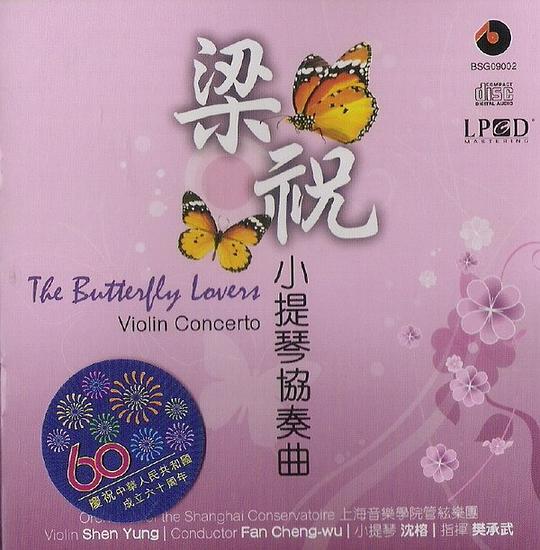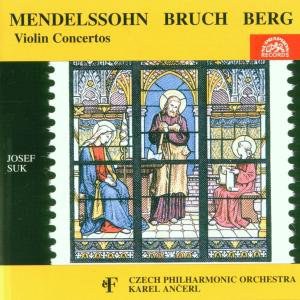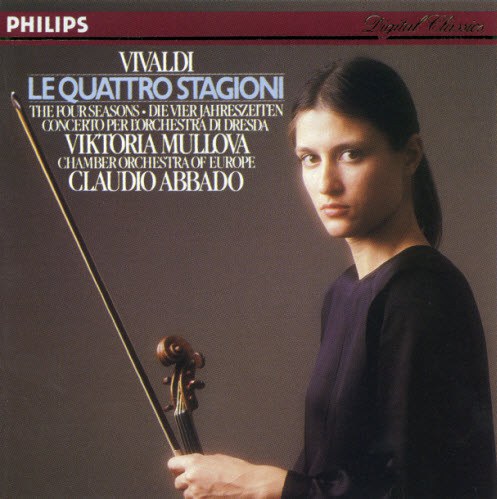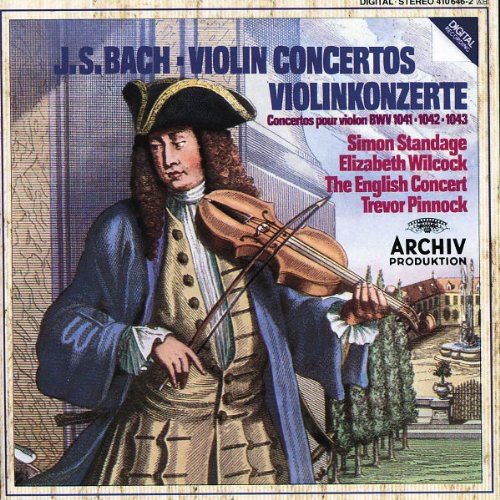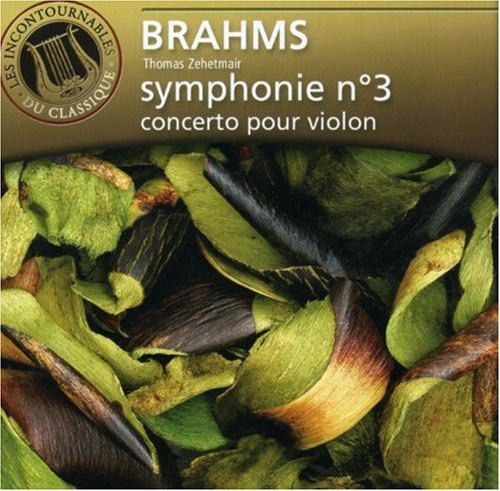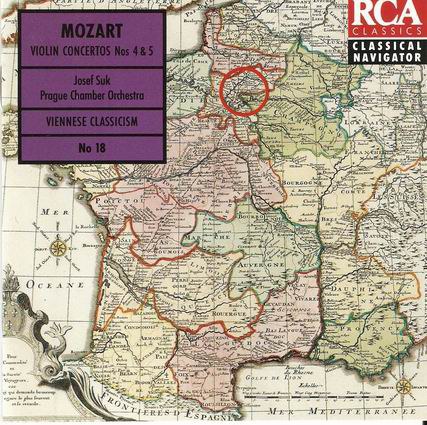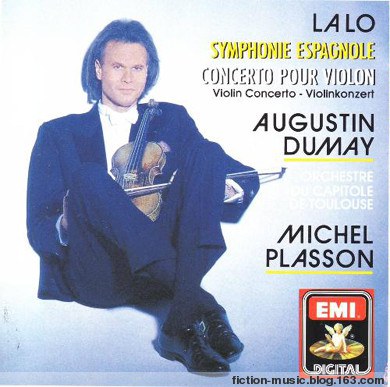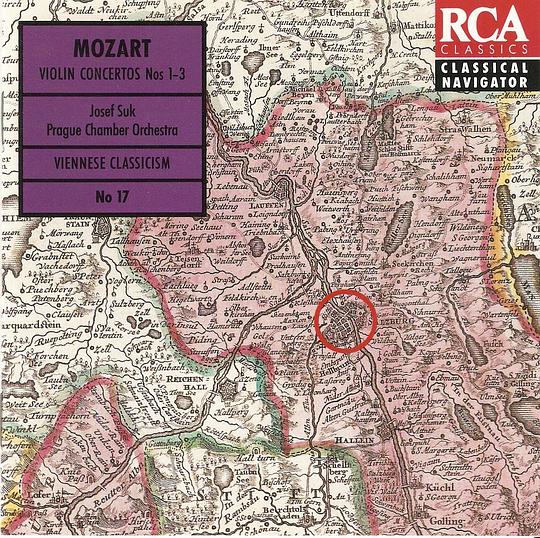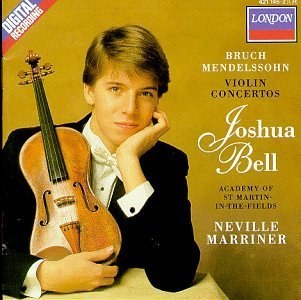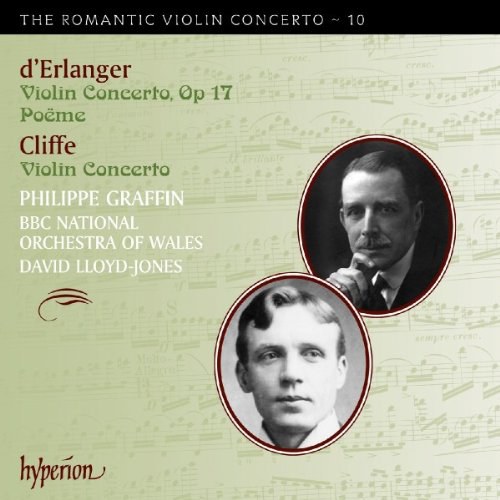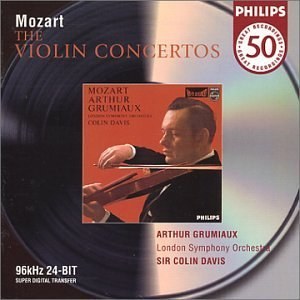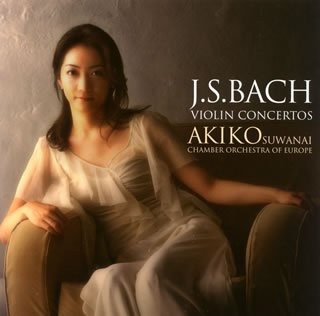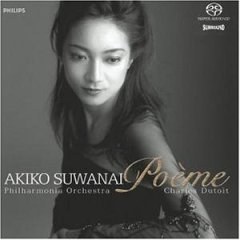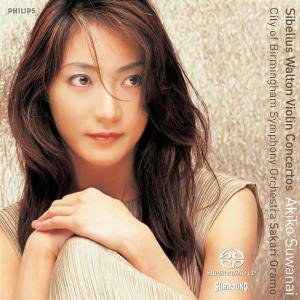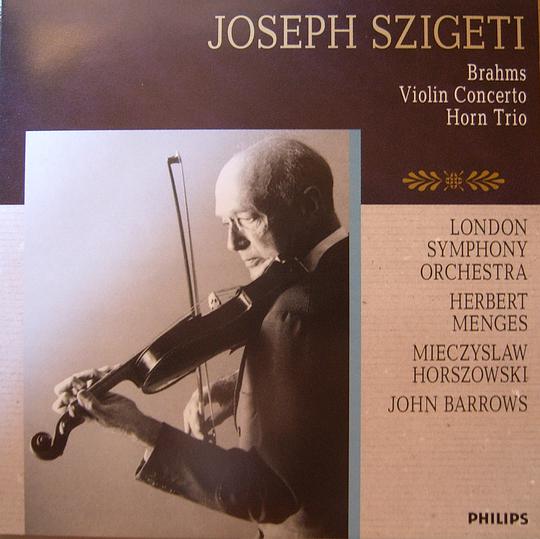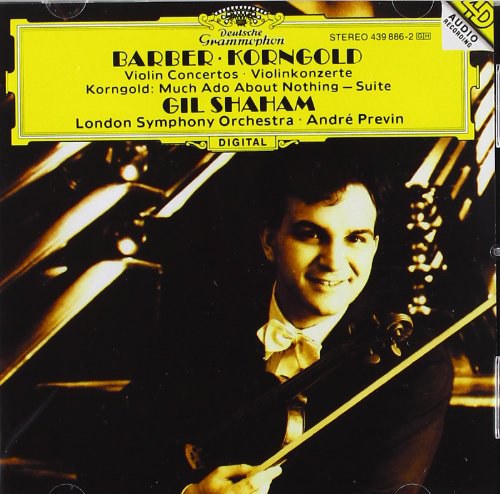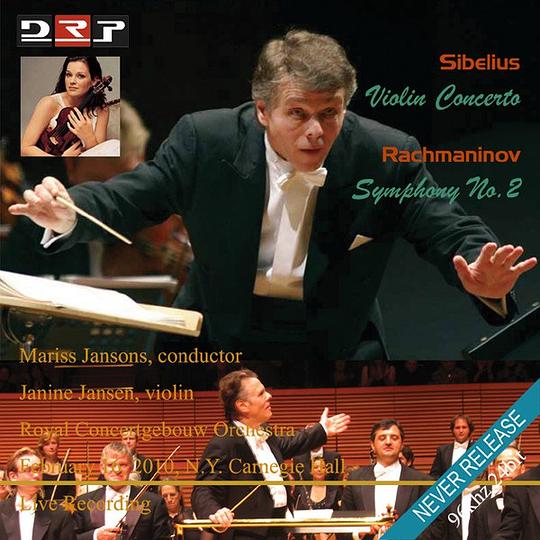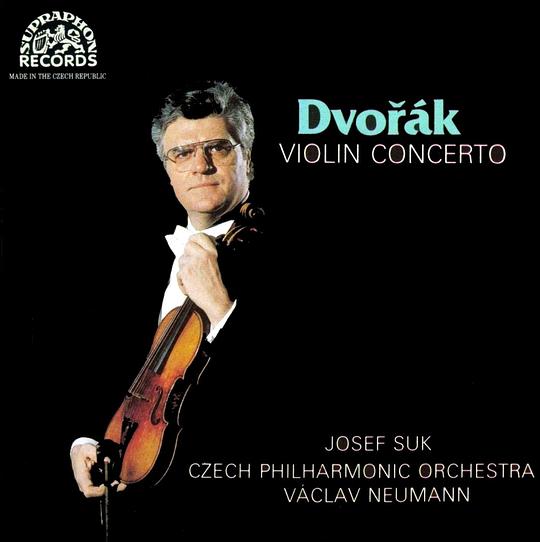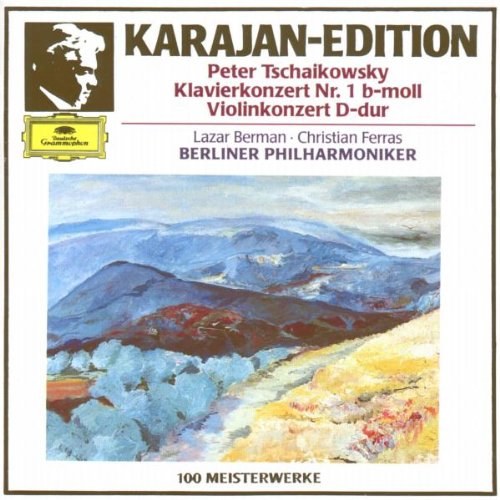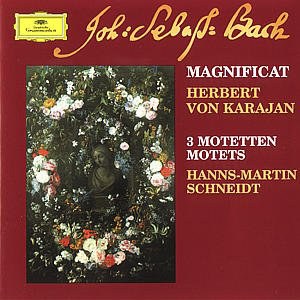小协
约瑟夫·苏克独奏,卡雷尔·安切尔指挥捷克爱乐乐团:门德尔松、布鲁赫,贝尔格小提琴协奏曲 豆瓣
Josef Suk
/
Karel Ančerl
…
类型:
古典
发布日期 1995年10月24日
出版发行:
Supraphon
穆洛娃 阿巴多:维瓦尔第 四季 豆瓣
Viktoria Mullova
/
Claudio Abbado
…
类型:
古典
发布日期 1999年10月1日
出版发行:
PHILIPS
Bach: Violin Concertos BWV 1041, 1042, 1043 豆瓣
Trevor Pinnock
/
Simon Standage
…
发布日期 1984年5月18日
出版发行:
Archiv
CD
多赫南伊指挥克利夫兰管弦乐团,柴赫迈尔:勃拉姆斯第三交响曲;小提琴协奏曲 豆瓣
Christoph von Dohnanyi
/
Thomas Zehetmair
…
类型:
古典
发布日期 2002年11月18日
出版发行:
Teldec
约瑟夫·苏克:莫扎特小提琴协奏曲 4号 5号 豆瓣
Josef Suk
/
Libor Hlavacek
…
类型:
古典
发布日期 1994年11月18日
出版发行:
RCA
Augustin Dumay :Lalo Symphonie Espagnole, Violin Concerto No.1 豆瓣
Augustin Dumay
/
Michel Plasson
…
类型:
古典
发布日期 1990年1月1日
出版发行:
EMI
拉罗(Edouard Lalo,1823-1892)的这两部小提琴协奏曲(人们普遍认同《西班牙交响曲》是一部小提琴协奏曲)在今天真可谓是冰火两重天,《西班牙交响曲》成为耳熟能详的作品,几乎是拉罗的代名词;而真正的小协却是少有演奏和录音。其实在当年,两部作品都是很受欢迎的,今天的人们过于“跟风”,以至于把同样优美动听、甚至更为深沉、更为感人的小协都快扔到垃圾堆里去了。
两部作品都是题献给萨拉萨蒂的,萨拉萨蒂对两部作品都非常钟爱,都是经他首演。可以说《西班牙交响曲》成就了拉罗的声名,然而拉罗自己不这么看,他认为萨拉萨蒂才是至关重要的。“如果没有你,我就只能睡觉,或者写点无所谓的东西。是你唤醒了我。。。你就是我的清新空气。”拉罗在给萨拉萨蒂的信中这样写道。相信拉罗是真诚的,感激的。
其实,拉罗还有一部名为“俄罗斯协奏曲”的作品,实际也是一部小提琴协奏曲。今天已经不是太清楚为什么萨拉萨蒂没有演奏它。对很多人而言,大概这无关紧要,因为有《西班牙交响曲》就够了。
但是,要全面了解拉罗的音乐,我们还应该仔细听听他的小协,以及他的俄罗斯协奏曲(以后介绍),因为拉罗是那种旋律至上的作曲家,对于许多偏好旋律的爱乐者来说,他的动人的音乐每一部都值得用心聆听。
这个版本将两部作品放在一起,非常难得。Dumay也许没有帕尔曼的名气大,但他的演奏真的很狂放,很激情,还很富有诗意,又是原汁原味的法国乐队和法国指挥,真不输任何版本。只是现在要得到这个版本可能不太容易。
两部作品都是题献给萨拉萨蒂的,萨拉萨蒂对两部作品都非常钟爱,都是经他首演。可以说《西班牙交响曲》成就了拉罗的声名,然而拉罗自己不这么看,他认为萨拉萨蒂才是至关重要的。“如果没有你,我就只能睡觉,或者写点无所谓的东西。是你唤醒了我。。。你就是我的清新空气。”拉罗在给萨拉萨蒂的信中这样写道。相信拉罗是真诚的,感激的。
其实,拉罗还有一部名为“俄罗斯协奏曲”的作品,实际也是一部小提琴协奏曲。今天已经不是太清楚为什么萨拉萨蒂没有演奏它。对很多人而言,大概这无关紧要,因为有《西班牙交响曲》就够了。
但是,要全面了解拉罗的音乐,我们还应该仔细听听他的小协,以及他的俄罗斯协奏曲(以后介绍),因为拉罗是那种旋律至上的作曲家,对于许多偏好旋律的爱乐者来说,他的动人的音乐每一部都值得用心聆听。
这个版本将两部作品放在一起,非常难得。Dumay也许没有帕尔曼的名气大,但他的演奏真的很狂放,很激情,还很富有诗意,又是原汁原味的法国乐队和法国指挥,真不输任何版本。只是现在要得到这个版本可能不太容易。
Josef Suk:Mozart - Violin Concerto No.1-3 豆瓣
Josef Suk
/
Libor Hlavacek
…
类型:
古典
发布日期 1994年11月18日
出版发行:
RCA
约书亚·贝尔:布鲁赫第一小提琴协奏曲/门德尔松小提琴协奏曲 豆瓣 Spotify
Joshua Bell
/
Academy of St Martin-in-the-Fields
类型:
古典
发布日期 1988年1月1日
出版发行:
Decca
Born 1967; this recording 1988.
德·厄兰格:小提琴协奏曲/音诗;克利夫:小提琴协奏曲 豆瓣
Philippe Graffin
/
BBC Scottish Symphony Orchestra
…
类型:
古典
发布日期 2010年4月1日
出版发行:
Hyperion
BARON Frédéric Alfred d’Erlanger was a banker,
born in Paris but with a German father and
American mother, who moved to London in his
teens. He was naturalized British and long resident in
London, where he was involved in promoting music and
was later a trustee of the London Philharmonic Orchestra
and on the board of the Royal Opera House, Covent
Garden. He was also a composer, his teacher being Anselm
Ehmant, a close friend of the family, and although his
catalogue of works is not huge, throughout his life there
was a steady stream of first performances bythe most
celebrated artists and orchestras of the day. Many record
collectors will have come across him as the composer of
the ballet music Les cent baisers, recorded by Dorati and
the London Symphony Orchestra after its success when
danced at Covent Garden in 1935.
D’Erlanger had first appeared as a composer with his
opéra comique Jehan de Saintré, produced in Aix-les-
Bains in 1893 and in Hamburg the following year. He first
appeared at Covent Garden as a stage composer in July
1897, under the pseudonym Frédéric Regnal, with the
opera Inès Mendo after Mérimée’s comedy. Later, with
theGerman title Das Erbe, it was produced in Hamburg,
Frankfurt and Moscow.
If we track his music through his published works,
andlater through performances at the Queen’s Hall
Promenade Concerts, we find a Prelude for violin and
piano published in 1895 and an album of six songs in
1896. He appeared at the Proms in September 1895 with
a Suite symphonique, and by 1900 had published a Violin
Sonata in G minor and in 1901 a notable Piano Quintet,
which was given a rousing reception at the 1902 ‘Pops’ at
St James’s Hall. New works appeared at regular intervals
during his life: just following the Proms we find the
Andante symphonique Op 18 for cello and orchestra in
October 1904, and the symphonic prelude Sursum Corda!
in August 1919. There was also the Concerto symphonique
for piano and orchestra from 1921 and the gorgeous
Messe de Requiem of 1930, a work admired by Adrian
Boult, who arranged its broadcast in 1931 and a public
performance in Birmingham in 1933, where it was revived
as recently as March 2001. The briefly popular orchestral
waltz Midnight Rose was recorded by Barbirolli in 1934.
Possibly d’Erlanger’s most famous work was his opera,
in Italian, after Thomas Hardy’s Tess of the d’Urbervilles.
Someone with d’Erlanger’s connections would only con-
sider the best as his collaborators and he asked Luigi Illica,
Puccini’s librettist, to write the libretto. Its first production
at the San Carlo Theatre in Naples in 1906 was interrupted
by a volcanic eruption of Mount Vesuvius. The Naples
production spawned early recordings by Amedeo Bassi and
Alessandro Bonci of Angel Clare’s aria in Act I. Produced
inLondon in 1909 with no less a cast than Emmy Destin
as Tess and Zenatello as Angel Clare, it was revived in 1910
and later produced at Chemnitz and Budapest. Tess was
revived by the BBC in 1929 in an English version. In 1910
his opera Noël was produced atthe Paris Opéra and
subsequently in Chicago, Philadelphia, Montreal and
Stockholm.
So d’Erlanger’s Violin Concerto was the work of a
significant emerging composer when it was written in
1902. It was first performed by Hugo Heermann, then still
the long-standing professor of violin at the Hoch’sche
Konservatorium in Frankfurt, and he played it in Holland
and Germany before it was taken up by Fritz Kreisler and
given its British premiere at the Philharmonic Society
concert at Queen’s Hall on 12 March 1903. Published
byRahter of Hamburg in 1903, it was later played at
Bournemouth in 1909, 1920 and 1928, as well as at the
Queen’s Hall Proms (by Albert Sammons) in 1921.
Notable for the transparency of its scoring, d’Erlanger’s
concerto launches straight into the first subject, an-nounced by the soloist in triple- and double-stopped
chords without an orchestral introduction. The soloist
soars away in running semiquavers, eventually presenting
a more lyrical version of the theme and immediately
moving on to the singing second subject. A succession
ofrising trills by the soloist leads to a cadenza-like
unaccompanied middle-section before the first subject
reappears in the orchestra. The lyrical second subject
returns in various keys and with a short coda, Allegro
animando, the horns herald the close and a brief gesture
of dismissal.
The composer’s treatment of the orchestra—with
constantly varied touches of instrumental colour, and
often with only two or three instruments playing, typically
answering each other—is particularly characteristic in the
gorgeous slow movement. A nine-bar introduction creates
a nocturnal atmosphere with bell-like notes on flute and
harp over hushed strings. The cor anglais then sings the
plaintive first subject, immediately repeated and extended
by the soloist. After thirty-one bars it is taken up by the
clarinet, the soloist now accompanying with arpeggiated
chords across the strings. The second subject follows on
the strings with rising decorations by the soloist. The first
theme is repeated, now in F minor, with muted accom-
panying strings. A haunting romantic motif is heard on the
horns and will be heard several times before the end.
Eventually a cadenza-like passage of running semiquavers
presages the return of the cor anglais and a brief
orchestral climax before, musing on the horn’s romantic
motif, the music fades on the soloist’s long-held pianis-
simo top C.
The finale comes as a great surprise—a diaphanous
scherzando, all fairy gossamer. The music falls into a
succession of sixteen related short episodes. The first
theme starts in
and proceeds in
, its leaping triplet
motion giving it the feel of a saltarello. A contrasted theme in
appears in the strings in the fifth episode, and in the
next the first theme of the first movement returns in
staccato crochets. The writing for the soloist is brilliant
throughout, though d’Erlanger does not feel the need for
another cadenza.
born in Paris but with a German father and
American mother, who moved to London in his
teens. He was naturalized British and long resident in
London, where he was involved in promoting music and
was later a trustee of the London Philharmonic Orchestra
and on the board of the Royal Opera House, Covent
Garden. He was also a composer, his teacher being Anselm
Ehmant, a close friend of the family, and although his
catalogue of works is not huge, throughout his life there
was a steady stream of first performances bythe most
celebrated artists and orchestras of the day. Many record
collectors will have come across him as the composer of
the ballet music Les cent baisers, recorded by Dorati and
the London Symphony Orchestra after its success when
danced at Covent Garden in 1935.
D’Erlanger had first appeared as a composer with his
opéra comique Jehan de Saintré, produced in Aix-les-
Bains in 1893 and in Hamburg the following year. He first
appeared at Covent Garden as a stage composer in July
1897, under the pseudonym Frédéric Regnal, with the
opera Inès Mendo after Mérimée’s comedy. Later, with
theGerman title Das Erbe, it was produced in Hamburg,
Frankfurt and Moscow.
If we track his music through his published works,
andlater through performances at the Queen’s Hall
Promenade Concerts, we find a Prelude for violin and
piano published in 1895 and an album of six songs in
1896. He appeared at the Proms in September 1895 with
a Suite symphonique, and by 1900 had published a Violin
Sonata in G minor and in 1901 a notable Piano Quintet,
which was given a rousing reception at the 1902 ‘Pops’ at
St James’s Hall. New works appeared at regular intervals
during his life: just following the Proms we find the
Andante symphonique Op 18 for cello and orchestra in
October 1904, and the symphonic prelude Sursum Corda!
in August 1919. There was also the Concerto symphonique
for piano and orchestra from 1921 and the gorgeous
Messe de Requiem of 1930, a work admired by Adrian
Boult, who arranged its broadcast in 1931 and a public
performance in Birmingham in 1933, where it was revived
as recently as March 2001. The briefly popular orchestral
waltz Midnight Rose was recorded by Barbirolli in 1934.
Possibly d’Erlanger’s most famous work was his opera,
in Italian, after Thomas Hardy’s Tess of the d’Urbervilles.
Someone with d’Erlanger’s connections would only con-
sider the best as his collaborators and he asked Luigi Illica,
Puccini’s librettist, to write the libretto. Its first production
at the San Carlo Theatre in Naples in 1906 was interrupted
by a volcanic eruption of Mount Vesuvius. The Naples
production spawned early recordings by Amedeo Bassi and
Alessandro Bonci of Angel Clare’s aria in Act I. Produced
inLondon in 1909 with no less a cast than Emmy Destin
as Tess and Zenatello as Angel Clare, it was revived in 1910
and later produced at Chemnitz and Budapest. Tess was
revived by the BBC in 1929 in an English version. In 1910
his opera Noël was produced atthe Paris Opéra and
subsequently in Chicago, Philadelphia, Montreal and
Stockholm.
So d’Erlanger’s Violin Concerto was the work of a
significant emerging composer when it was written in
1902. It was first performed by Hugo Heermann, then still
the long-standing professor of violin at the Hoch’sche
Konservatorium in Frankfurt, and he played it in Holland
and Germany before it was taken up by Fritz Kreisler and
given its British premiere at the Philharmonic Society
concert at Queen’s Hall on 12 March 1903. Published
byRahter of Hamburg in 1903, it was later played at
Bournemouth in 1909, 1920 and 1928, as well as at the
Queen’s Hall Proms (by Albert Sammons) in 1921.
Notable for the transparency of its scoring, d’Erlanger’s
concerto launches straight into the first subject, an-nounced by the soloist in triple- and double-stopped
chords without an orchestral introduction. The soloist
soars away in running semiquavers, eventually presenting
a more lyrical version of the theme and immediately
moving on to the singing second subject. A succession
ofrising trills by the soloist leads to a cadenza-like
unaccompanied middle-section before the first subject
reappears in the orchestra. The lyrical second subject
returns in various keys and with a short coda, Allegro
animando, the horns herald the close and a brief gesture
of dismissal.
The composer’s treatment of the orchestra—with
constantly varied touches of instrumental colour, and
often with only two or three instruments playing, typically
answering each other—is particularly characteristic in the
gorgeous slow movement. A nine-bar introduction creates
a nocturnal atmosphere with bell-like notes on flute and
harp over hushed strings. The cor anglais then sings the
plaintive first subject, immediately repeated and extended
by the soloist. After thirty-one bars it is taken up by the
clarinet, the soloist now accompanying with arpeggiated
chords across the strings. The second subject follows on
the strings with rising decorations by the soloist. The first
theme is repeated, now in F minor, with muted accom-
panying strings. A haunting romantic motif is heard on the
horns and will be heard several times before the end.
Eventually a cadenza-like passage of running semiquavers
presages the return of the cor anglais and a brief
orchestral climax before, musing on the horn’s romantic
motif, the music fades on the soloist’s long-held pianis-
simo top C.
The finale comes as a great surprise—a diaphanous
scherzando, all fairy gossamer. The music falls into a
succession of sixteen related short episodes. The first
theme starts in
and proceeds in
, its leaping triplet
motion giving it the feel of a saltarello. A contrasted theme in
appears in the strings in the fifth episode, and in the
next the first theme of the first movement returns in
staccato crochets. The writing for the soloist is brilliant
throughout, though d’Erlanger does not feel the need for
another cadenza.
Mozart: The Violin Concertos 豆瓣
9.6 (5 个评分)
Arthur Grumiaux
类型:
古典
发布日期 2001年4月23日
出版发行:
Philips
格鲁米欧的莫扎特小提琴协奏曲全集,三星带花,经典地位无可动摇。这个版本是用96KHz 24-BIT超级数码转换技术重新制作发行的,是飞利浦用该技术制作的50个伟大录音系列中的一张。CD1里还收录了两首小提琴奏鸣曲,哈斯姬尔伴奏。
诹访内晶子:巴赫双小提琴协奏曲:两首小提琴协奏曲 豆瓣
诹访内晶子 Akiko Suwanai
类型:
古典
发布日期 2008年12月3日
出版发行:
Universal Japan
诹访内晶子Akiko Suwanai
日本小提琴家诹访内晶子,1972年生于东京,现今最年轻的柴可夫斯基小提琴大赛金奖获得者。作为一位出色的独奏家,她创作了很多优秀的作品,并且在古典乐坛建立了很高的国际声誉。
诹访内晶子精湛技巧和热情投入的结合,在当今的舞台上极为少见。与她合作的众多著名的指挥家中,包括伊利亚胡·殷巴尔,洛林·马泽尔,祖宾·梅塔,小泽征尔和潘德烈茨基等。她经常与纽约和洛杉矶爱乐乐团,波士顿交响乐团,华盛顿国家交响乐团,明尼苏达州和辛辛那提交响乐团合作赴北美作精彩演出。
诹访内晶子还与环球唱片公司签下独家唱片合同,她录制的七张专辑引起很大的关注,喝彩不断。2004年发行的最近一张专辑,是与指挥家夏尔·迪图瓦联合爱乐乐团演奏的法国歌剧。
诹访内晶子不但摘取了意大利热那亚的帕格尼尼国际小提琴大赛的桂冠,还在日本国际比赛和比利时伊丽莎白女王国际比赛中胜出,所得奖项多不胜数。她曾在日本最著名的桐朋音乐院和美国朱丽亚音乐学院攻读小提琴,师从迪蕾和林昭亮,在柏林艺术学院跟随海伯格学琴。除了学习音乐外,还在美国哥伦比亚大学学习国际政治经济专业,可见其文化修养相当深厚。
诹访内晶子所用的小提琴是由意大利名匠-安托万史特拉瓦里(Antonio Stradivarius)制作的名琴「海豚Dolphin」,号称全球最好的五把小提琴之一,曾是她最欣赏的小提琴泰斗海菲茨的最爱。
她曾赢得过帕格尼尼、伊莉莎白小提琴大赛的第二名,并摘取过柴可夫斯基大赛的金牌,在古典音乐界已大有名气。印象中,有东方血统的小提琴女将已不足为先,郑京和、美岛丽、莎拉张个个威震世界。然而,她们中却没有一个象取访内晶子般还有令人妒忌的美貌。当安妮·索菲-穆特迈向半老徐娘之际,集迷人外貌、超技琴艺、慧黠头脑于一身的诹访内晶子将成为古典音乐界的新偶像,小提琴爱乐者最新的“梦中情人”。
日本小提琴家诹访内晶子,1972年生于东京,现今最年轻的柴可夫斯基小提琴大赛金奖获得者。作为一位出色的独奏家,她创作了很多优秀的作品,并且在古典乐坛建立了很高的国际声誉。
诹访内晶子精湛技巧和热情投入的结合,在当今的舞台上极为少见。与她合作的众多著名的指挥家中,包括伊利亚胡·殷巴尔,洛林·马泽尔,祖宾·梅塔,小泽征尔和潘德烈茨基等。她经常与纽约和洛杉矶爱乐乐团,波士顿交响乐团,华盛顿国家交响乐团,明尼苏达州和辛辛那提交响乐团合作赴北美作精彩演出。
诹访内晶子还与环球唱片公司签下独家唱片合同,她录制的七张专辑引起很大的关注,喝彩不断。2004年发行的最近一张专辑,是与指挥家夏尔·迪图瓦联合爱乐乐团演奏的法国歌剧。
诹访内晶子不但摘取了意大利热那亚的帕格尼尼国际小提琴大赛的桂冠,还在日本国际比赛和比利时伊丽莎白女王国际比赛中胜出,所得奖项多不胜数。她曾在日本最著名的桐朋音乐院和美国朱丽亚音乐学院攻读小提琴,师从迪蕾和林昭亮,在柏林艺术学院跟随海伯格学琴。除了学习音乐外,还在美国哥伦比亚大学学习国际政治经济专业,可见其文化修养相当深厚。
诹访内晶子所用的小提琴是由意大利名匠-安托万史特拉瓦里(Antonio Stradivarius)制作的名琴「海豚Dolphin」,号称全球最好的五把小提琴之一,曾是她最欣赏的小提琴泰斗海菲茨的最爱。
她曾赢得过帕格尼尼、伊莉莎白小提琴大赛的第二名,并摘取过柴可夫斯基大赛的金牌,在古典音乐界已大有名气。印象中,有东方血统的小提琴女将已不足为先,郑京和、美岛丽、莎拉张个个威震世界。然而,她们中却没有一个象取访内晶子般还有令人妒忌的美貌。当安妮·索菲-穆特迈向半老徐娘之际,集迷人外貌、超技琴艺、慧黠头脑于一身的诹访内晶子将成为古典音乐界的新偶像,小提琴爱乐者最新的“梦中情人”。
諏訪内晶子演奏法国浪漫主义小提琴曲 豆瓣
Akiko Suwanai
/
Philharmonia Orchestra
…
类型:
古典
发布日期 2004年11月18日
出版发行:
Philips
诹访内晶子:西贝柳斯、沃尔顿小提琴协奏曲 豆瓣
诹访内晶子 Akiko Suwanai
类型:
古典
发布日期 2008年9月2日
出版发行:
Decca Import
沃尔顿(W.William Walton,1902—1983)英国作曲家;1902年3月29日生于兰开夏郡的奥尔德姆,1983年3月8日卒于伊斯基亚岛。 1912年入牛津大教堂合唱学院,主要依靠自学掌握了作曲理论;他的音乐继承了浪漫主义传统,同时吸取各种现代手法。 早期作品如《门面》(1922)、为英国女作家E.西特韦尔的诗歌作朗诵配乐(后改编成两首管弦乐组曲)以及管弦乐序曲《朴次茅斯角》(1925)等,受到音乐界好评。从20年代末创作中提琴协奏曲开始,风格日趋成熟,长于抒情、幽默,技巧熟练特别是30年代的几部作品、如清唱剧《伯沙撒王的宴会》(1931,歌词内容选自《圣经》)、第一交响曲(1935)、小提琴协奏曲(1939)等,进一步确立了他作为英国重要作曲家的地位。 40年代以后,创作数量不多,重要作品有歌剧《特洛伊罗斯与克瑞西达》(1954)、大提琴协奏曲(1956)、第二交响曲(1960)等。 此外,他为电影谱写的音乐,如根据莎士比亚原著改编的《亨利五世》(1944)、《哈姆雷特》(1947)等,亦获得很大成功。
Joseph Szigeti-Brahms Violin Concerto&Horn Trio 豆瓣
Joseph Szigeti
/
Mieczyslaw Horszowski
…
发布日期 2006年1月1日
出版发行:
Philips
巴伯《小提琴协奏曲》 / 康戈尔德-电影配乐《诱骗》戏剧配乐《无事生非》 豆瓣
Gil Shaham
/
Andre Previn
…
发布日期 1994年8月16日
出版发行:
Deutsche Grammophon
巴伯协奏曲的第一个音符出来,就像磁铁一样吸住你的耳朵,沙汉姆的音色就像是午后照进屋内的阳光一般的感觉,是一种温暖的幸福感。所以我不太那这个作品当做是美国作品。
至于Korngold(我觉得翻译成“科恩戈尔德”很难听),我对于这个作曲家的了解只有这首小提琴协奏曲。他是一个挺有名的好莱坞作曲家,这首协奏曲里面的素材也都是用他自己的电影配乐串起来的。不过这是一首迷人的作品,优美的旋律,加上海费茨的着名演奏,使它声名远播。所以,哪个小提琴家录制这首协奏曲,都不免让人拿来跟海大师比较一番,最后的结论当然都是:跟大师相比,其他人都要略逊一筹。不过,我敢说,沙汉姆的演奏,绝对不逊于任何人,包括海费茨在内。
无论你对这两首协奏曲是否了解,就算是只想听一听唯美的小提琴音色,这张唱片绝对是不二之选。我当初就是听了这张唱片之后,对沙汉姆刮目相看,后来又听了他很多录音。过两天我准备把他另一张堪称绝世演奏的唱片”魔鬼之舞“发出来,请朋友们耐心等待。
这张唱片还搭配了一首Korngold的“无事生非”组曲,指挥家普列文担任钢琴伴奏。很有特色,而且这个录音是这首作品在市场上的“孤本”,所以还有一定的收藏价值
至于Korngold(我觉得翻译成“科恩戈尔德”很难听),我对于这个作曲家的了解只有这首小提琴协奏曲。他是一个挺有名的好莱坞作曲家,这首协奏曲里面的素材也都是用他自己的电影配乐串起来的。不过这是一首迷人的作品,优美的旋律,加上海费茨的着名演奏,使它声名远播。所以,哪个小提琴家录制这首协奏曲,都不免让人拿来跟海大师比较一番,最后的结论当然都是:跟大师相比,其他人都要略逊一筹。不过,我敢说,沙汉姆的演奏,绝对不逊于任何人,包括海费茨在内。
无论你对这两首协奏曲是否了解,就算是只想听一听唯美的小提琴音色,这张唱片绝对是不二之选。我当初就是听了这张唱片之后,对沙汉姆刮目相看,后来又听了他很多录音。过两天我准备把他另一张堪称绝世演奏的唱片”魔鬼之舞“发出来,请朋友们耐心等待。
这张唱片还搭配了一首Korngold的“无事生非”组曲,指挥家普列文担任钢琴伴奏。很有特色,而且这个录音是这首作品在市场上的“孤本”,所以还有一定的收藏价值
2010-8杨松斯美国巡演 豆瓣
马里斯·杨松斯 Mariss Jansons
/
皇家大会堂管弦乐团 Royal Concertgebouw Orchestra
…
类型:
古典
发布日期 2010年2月16日
出版发行:
Jim DRP
专辑名称:杨森斯美国巡演 (二〇一〇年二月)
乐团指挥:Mariss Jansons
乐团演奏:Royal Concertgebouw Orchestra 阿姆斯特丹皇家音乐厅管弦乐团
提琴独奏:Janine Jansen
演录时间:2010年2月16日,纽约现场录音 Live recording
版本来源:现场广播录音 Radio Broadcast
发行时间:Never Release 从未发行
资源出处:Jimdrp 自现场广播录制,私人收藏,原发
录音音质:以 96kHz 24-bit Wav 直录 (以及 44kHz 24-bit APE)
[注:此APE乃本人自电脑播放96khz 24bit WAV再以CD录之,原只为自己在开车时方便聆听,质量可想而知。欲聆听原始WAV和高品质音源者可往本人博客下载。]
演出节目:
Sibelius: Violin Concerto
Rachmaninov: Symphony No. 2
乐团指挥:Mariss Jansons
乐团演奏:Royal Concertgebouw Orchestra 阿姆斯特丹皇家音乐厅管弦乐团
提琴独奏:Janine Jansen
演录时间:2010年2月16日,纽约现场录音 Live recording
版本来源:现场广播录音 Radio Broadcast
发行时间:Never Release 从未发行
资源出处:Jimdrp 自现场广播录制,私人收藏,原发
录音音质:以 96kHz 24-bit Wav 直录 (以及 44kHz 24-bit APE)
[注:此APE乃本人自电脑播放96khz 24bit WAV再以CD录之,原只为自己在开车时方便聆听,质量可想而知。欲聆听原始WAV和高品质音源者可往本人博客下载。]
演出节目:
Sibelius: Violin Concerto
Rachmaninov: Symphony No. 2
Dvorak: Violin Concerto in A Minor, Op.53. Josef Suk: Fantasy in G Minor, for Violin & Orchestra, Op.24 - Josef Suk/Vaclav Neumann, Czech Philharmonic Orchestra 豆瓣
Josef Suk (Composer)
/
Josef Suk (Violin)
…
发布日期 1994年9月22日
出版发行:
Supraphon
柴可夫斯基:第一钢琴协奏曲, 小提琴协奏曲 豆瓣
9.8 (8 个评分)
Herbert von Karajan
/
Lazar Berman
…
类型:
古典
发布日期 1989年1月1日
出版发行:
Polygram Records
这套《 柴可夫斯基 - No. 1 钢琴协奏曲 :No . 1 钢琴协奏曲 及 小提琴协奏曲》 由DG 唱片公司发行于1989 年,分别由钢琴家拉扎尔• 贝尔曼 和 小提琴家克里斯蒂安• 费拉斯主奏, 赫伯特• 冯• 卡拉扬指挥柏林爱乐乐团演奏录制.
拉扎尔• 贝尔曼(Lazar Bermen , 1930) 一是20 世纪俄罗斯著名的钢琴家之一,以触键轻巧、音色厚实、有光泽,和弦处理鲜明,弹奏速度自然,表情细致而著称于世.他对作品的诊释,常常是在整体把握音乐的创作构思下,充分表达自己丰富的想象力,既有缠绵、柔美之情,也有铿锵、恢宏之势.贝尔曼擅长演奏李斯特的作品,他于1963 年演录的李斯特的《 超级练习曲》 的唱片,深得卡拉扬的赏识.其次,他更擅长演奏俄罗斯作曲家的作品,尤其是柴可夫斯基的作品,那种在独自黯淡色调中隐藏着温暖情感的演绎无人能及,经他演奏和录制的柴可夫斯基的《 第一钢琴协奏曲》 ,被公认为是权威性的版本,深受乐迷的喜爱和欢迎.
法国小提琴家克里斯蒂安• 费拉斯(Christian Ferras) ,先后在尼斯音乐学院和巴黎音乐学院从比斯德西(Bistesi)和卡威(Calvet)学习,曾获小提琴演奏和室内乐演奏奖.后又从埃乃斯库学习,17 岁参加蒂博国际小提琴比赛获第一名,尔后开始巡回演奏口其音色壮丽多采,卡拉扬与其合作的协奏曲,尤其好评如潮. 1960年开始费拉斯成为卡拉扬最喜爱的小提琴家并成为柏林爱乐人气指数最高的音乐家
赫伯特• 冯• 卡拉扬(Herbert von Karajan )为伟大的奥地利指挥家.自幼学钢琴,曾进维也纳音乐学校和萨尔兹堡的莫扎特音乐学院学习.他的指挥生涯先从小城乌尔姆开始,1938 年被聘为柏林歌剧院的指挥,1947 年任维也纳爱乐乐团和维也纳乐友协会管弦乐队指挥,1949 年起兼任米兰• 斯卡拉歌剧院常任指挥,1950 年兼任伦敦爱乐乐团常任指挥,1955 年起任柏林爱乐乐团的终身常任指挥,1956 年任维也纳国立歌剧院的音乐总指导.他是现代最著名的指挥家之一,人们称他为“欧洲音乐的总指导”。他也是拜罗伊特、萨尔兹堡音乐节的主要人物.1967 年开始主办他个人的音乐节― 复活节音乐周.
卡拉扬的指挥动作洒脱、大方、气势磅礴,并以准确和客观著称.卡拉扬有惊人的指挥技巧,与乐队的配合如水乳交融般天衣无缝,通过热情洋溢、奔放豪迈的演奏,将音乐准确而强有力地传达给听众。他擅长在忠实于原作的基础上,对作品进行精雕细刻、巧妙布局,甚至适度夸张,而这一切都围绕着塑造完美的音乐形象而进行。在指挥台上卡拉扬经常闭目深思,使得乐队各声部之间达到了演奏室内乐般的默契.在他的领导下,柏林爱乐乐团展现出了一种有如金属般的亮色,被誉为卡拉扬“音响”.卡拉扬指挥时不仅自己全身心投入音乐之中,而且还善于启发乐队队员,使他们懂得如何演奏,用魔法般的动作牢牢吸引住乐队.他所追求的目标就是,“把托斯卡尼尼的精确与富尔特文格勒的幻想结合在一起”。正是他的音乐天赋,加上对乐曲的正确理解和对乐队的严格要求,他的演出总能达到超常出众的艺术水平.
Tchaikovsky's Piano Concerto No. 1 in B flat minor op. 23, composed in Moscow during November and December 1874 and orchestrated during the next two months, is possibly the best-known and best-loved of all piano concertos. It is full of original ideas presented in a masterly fashion. It owes its popularity, however, less to these qualities than to the scope which it offers for dazzling pianistic virtuosity - and to the grandiose maestoso introduction to its firs movement, whose brash power and melodic simplicity can enthrall the listener - or repel him. "This" Tchaikovsky is really a matter of taste! However, the musical material of this celebrated (or notorious) introduction plays no further part, either during the first movement or in the rest of the work.
According to Modest Tchaikovsky, his brother originally intended to dedicate the First Piano Concerto to his friend the pianist and conductor Nikolai Rubinstein. Rubinstein generally helped and encouraged the young composer, but he criticized this concerto so harshly that Tchaikovsky, deeply offended and disappointed, turned to the great German conductor and pianist Hans von Bülow. (Thomas Kohlhase)
The expression "stinking music" which Eduard Hanslick used in 1881 after hearing Tchaikovsky's Violin Concerto, has often been angrily rebutted by laters writers. Tchaikovsky himself felt deeply offended when he heard about Hanslick's criticism. In fact, however, Hanslick had a high opinion for other works by Tchaikovsky. His attitude to the Violin Concerto was misunderstood. As a devotee of absolute music Hanslick not only took a sceptical view of all composers of "music of the future", among whom he included Tchaikovsky, but saw the turn away from Classical principles as a symptomatic of music in decline. There was also the fact that the Violin Concerto by Brahms, which had been written at about the same time as Tchaikovsky's concerto, and which Hanslick valued particulary highly, was diametrically opposed in its expressive content to Tchaikovsky's work. By comparison with the cool reserve and rarefied tonal language of Brahms, the unbridled expressive power of Tchaikovsky's music was bound to offend Hanslick's susceptibilities. That was what his words signified. Here were two utterly different concepts of the nature of a concerto. Hanslick's adverse reaction is fully understandable only when we remember that Tchaikovsky rejected the music of Brahms as pretentious and "without genuine depth", and described Brahms to Nadezhda von Meck as a "composer without any creative power". (Heinz Becker)
拉扎尔• 贝尔曼(Lazar Bermen , 1930) 一是20 世纪俄罗斯著名的钢琴家之一,以触键轻巧、音色厚实、有光泽,和弦处理鲜明,弹奏速度自然,表情细致而著称于世.他对作品的诊释,常常是在整体把握音乐的创作构思下,充分表达自己丰富的想象力,既有缠绵、柔美之情,也有铿锵、恢宏之势.贝尔曼擅长演奏李斯特的作品,他于1963 年演录的李斯特的《 超级练习曲》 的唱片,深得卡拉扬的赏识.其次,他更擅长演奏俄罗斯作曲家的作品,尤其是柴可夫斯基的作品,那种在独自黯淡色调中隐藏着温暖情感的演绎无人能及,经他演奏和录制的柴可夫斯基的《 第一钢琴协奏曲》 ,被公认为是权威性的版本,深受乐迷的喜爱和欢迎.
法国小提琴家克里斯蒂安• 费拉斯(Christian Ferras) ,先后在尼斯音乐学院和巴黎音乐学院从比斯德西(Bistesi)和卡威(Calvet)学习,曾获小提琴演奏和室内乐演奏奖.后又从埃乃斯库学习,17 岁参加蒂博国际小提琴比赛获第一名,尔后开始巡回演奏口其音色壮丽多采,卡拉扬与其合作的协奏曲,尤其好评如潮. 1960年开始费拉斯成为卡拉扬最喜爱的小提琴家并成为柏林爱乐人气指数最高的音乐家
赫伯特• 冯• 卡拉扬(Herbert von Karajan )为伟大的奥地利指挥家.自幼学钢琴,曾进维也纳音乐学校和萨尔兹堡的莫扎特音乐学院学习.他的指挥生涯先从小城乌尔姆开始,1938 年被聘为柏林歌剧院的指挥,1947 年任维也纳爱乐乐团和维也纳乐友协会管弦乐队指挥,1949 年起兼任米兰• 斯卡拉歌剧院常任指挥,1950 年兼任伦敦爱乐乐团常任指挥,1955 年起任柏林爱乐乐团的终身常任指挥,1956 年任维也纳国立歌剧院的音乐总指导.他是现代最著名的指挥家之一,人们称他为“欧洲音乐的总指导”。他也是拜罗伊特、萨尔兹堡音乐节的主要人物.1967 年开始主办他个人的音乐节― 复活节音乐周.
卡拉扬的指挥动作洒脱、大方、气势磅礴,并以准确和客观著称.卡拉扬有惊人的指挥技巧,与乐队的配合如水乳交融般天衣无缝,通过热情洋溢、奔放豪迈的演奏,将音乐准确而强有力地传达给听众。他擅长在忠实于原作的基础上,对作品进行精雕细刻、巧妙布局,甚至适度夸张,而这一切都围绕着塑造完美的音乐形象而进行。在指挥台上卡拉扬经常闭目深思,使得乐队各声部之间达到了演奏室内乐般的默契.在他的领导下,柏林爱乐乐团展现出了一种有如金属般的亮色,被誉为卡拉扬“音响”.卡拉扬指挥时不仅自己全身心投入音乐之中,而且还善于启发乐队队员,使他们懂得如何演奏,用魔法般的动作牢牢吸引住乐队.他所追求的目标就是,“把托斯卡尼尼的精确与富尔特文格勒的幻想结合在一起”。正是他的音乐天赋,加上对乐曲的正确理解和对乐队的严格要求,他的演出总能达到超常出众的艺术水平.
Tchaikovsky's Piano Concerto No. 1 in B flat minor op. 23, composed in Moscow during November and December 1874 and orchestrated during the next two months, is possibly the best-known and best-loved of all piano concertos. It is full of original ideas presented in a masterly fashion. It owes its popularity, however, less to these qualities than to the scope which it offers for dazzling pianistic virtuosity - and to the grandiose maestoso introduction to its firs movement, whose brash power and melodic simplicity can enthrall the listener - or repel him. "This" Tchaikovsky is really a matter of taste! However, the musical material of this celebrated (or notorious) introduction plays no further part, either during the first movement or in the rest of the work.
According to Modest Tchaikovsky, his brother originally intended to dedicate the First Piano Concerto to his friend the pianist and conductor Nikolai Rubinstein. Rubinstein generally helped and encouraged the young composer, but he criticized this concerto so harshly that Tchaikovsky, deeply offended and disappointed, turned to the great German conductor and pianist Hans von Bülow. (Thomas Kohlhase)
The expression "stinking music" which Eduard Hanslick used in 1881 after hearing Tchaikovsky's Violin Concerto, has often been angrily rebutted by laters writers. Tchaikovsky himself felt deeply offended when he heard about Hanslick's criticism. In fact, however, Hanslick had a high opinion for other works by Tchaikovsky. His attitude to the Violin Concerto was misunderstood. As a devotee of absolute music Hanslick not only took a sceptical view of all composers of "music of the future", among whom he included Tchaikovsky, but saw the turn away from Classical principles as a symptomatic of music in decline. There was also the fact that the Violin Concerto by Brahms, which had been written at about the same time as Tchaikovsky's concerto, and which Hanslick valued particulary highly, was diametrically opposed in its expressive content to Tchaikovsky's work. By comparison with the cool reserve and rarefied tonal language of Brahms, the unbridled expressive power of Tchaikovsky's music was bound to offend Hanslick's susceptibilities. That was what his words signified. Here were two utterly different concepts of the nature of a concerto. Hanslick's adverse reaction is fully understandable only when we remember that Tchaikovsky rejected the music of Brahms as pretentious and "without genuine depth", and described Brahms to Nadezhda von Meck as a "composer without any creative power". (Heinz Becker)
Meisterwerke Vol. 8 (Magnificat & 3 Motetten) 豆瓣
Anna Tomowa-Sintow
/
Agnes Baltsa
…
类型:
古典
发布日期 1999年2月22日
出版发行:
Dg
